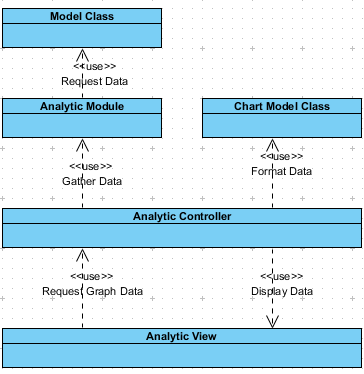CSC/ECE 517 Spring 2013/OSS E734: Difference between revisions
| Line 70: | Line 70: | ||
'''TODO:''' currently the Chart class located in the helper folder, this is not the proper location for the file. The file should be move to the models folder and rename to analytic.rb. | '''TODO:''' currently the Chart class located in the helper folder, this is not the proper location for the file. The file should be move to the models folder and rename to analytic.rb. | ||
== | == View == | ||
== Controller == | |||
= Access Control = | = Access Control = | ||
= Graphical User Interface Design = | = Graphical User Interface Design = | ||
Revision as of 22:54, 28 April 2013
This page is the design documentation for Expertiza project E734 conducted in the CSC/ECE 517 Spring 2003 class at North Carolina State University. Learn more about Expertiza by visiting its main page: http://wikis.lib.ncsu.edu/index.php/Expertiza
Team Members
Hao Liu (hliu11@ncsu.edu), Zhuowei Wang (zwang18@ncsu.edu), Chunxue Yang (cyang14@ncsu.edu)
Introduction
The Expertiza project is system for using peer review to create reusable learning objects. Students do different assignments; then peer review selects the best work in each category, and assembles it to create a single unit.
The process of reviewing includes reviews, re-reviews and meta reviews of assignments submitted by students for a course. This method of evaluation also inherently suggests that there will be vagaries in the way reviews have been performed.
This project aim to provide a way for the users to examine various type of statistic about the courses, assignments and reviews.
Objective
The original objective of the project is to extend the Analytic project E732 from previous semester to incorporate new features. Upon examination the implementation of E732 we decided to start from scratch and create a developer friendly and easily extendable framework for providing analytic data and displaying analytic data.
Architecture of the Analytic Framework
Architecture of the Expertiza Analytic Framework is based on the model-view-controller design pattern used in Rails application.

Model
There are two tasks that analytic require the model to perform: data mining and data formating.
Data Mining
The data mining operations gathers the data requested by the controller.
Original Implementation
In the original implementation of analytic, data mining methods use to extract the data are scattered between the assignment model class. There are several problems with this method of implementation.
First, assignment model is crucial class for the correct operation of the Expertiza and the data mining methods are not related to the normal operation that the model performs this reduces the readability and maintainability of the model.
Second, the data mining methods seem to recursively traverse through the data structure hierarchy level by level (for example: to obtain average grades for assignment, the original implementation do assignment->for each teams-> for each responses->score->grade) in-order to obtain the data that they need. This design violates basic object oriented programming principle, instead the data mining methods should be layered and methods should be added to the corresponding models to avoid this behavior.
New Implementation
The new implementation of analytic the data mining methods are implemented as mixin modules for the corresponding models. The modules are gathered into the /models/analytic folder. The modules contains the analytic methods for the model that they relates to. The analytic modules only calls the methods that are defined in model that they corresponds to and methods defined in other analytic module.
This implementation creates a clear separation between the normal model operation and data mining operation; abstract away the complexity of the structure of the underlying databases; improves the readability for the developer.
Related Files
Analytic modules and their corresponding models:
- expertiza/app/models/analytic/course_analytic.rb => expertiza/app/models/course.rb
- expertiza/app/models/analytic/assignment_analytic.rb => expertiza/app/models/assignment.rb
- expertiza/app/models/analytic/assignment_team_analytic.rb => expertiza/app/models/assignment_team.rb
- expertiza/app/models/analytic/questionnaire_analytic.rb => expertiza/app/models/questionnaire.rb
- expertiza/app/models/analytic/question_analytic.rb => expertiza/app/models/question.rb
- expertiza/app/models/analytic/response_analytic.rb => expertiza/app/models/response.rb
- expertiza/app/models/analytic/question_analytic.rb => expertiza/app/models/question.rb
- expertiza/app/models/analytic/score_analytic.rb => expertiza/app/models/score.rb
Data Formatting
The data formatting operations take the gathered data and formatted turn it into the format that are require by the methods that draws the charts that display the data.
Original Implementation
The original implementation of analytic have the controller handles data formatting function. In the MVC structure used in rails application, formatting the data is not a responsibility for the controller.
New Implementation
The new implementation of analytic a Chart class was created to handle the formatting of data. The Chart class serve as a interface between the java script based front-end in view and the ruby model back-end. The controller passes the graph type and data into the Chart class and the Chart class will handle all formatting and return the data that controller can pass into view.
The example for the input data format and how to use the Chart class will be provided in later section.
Related files
- expertiza/app/helpers/chart.rb
TODO: currently the Chart class located in the helper folder, this is not the proper location for the file. The file should be move to the models folder and rename to analytic.rb.